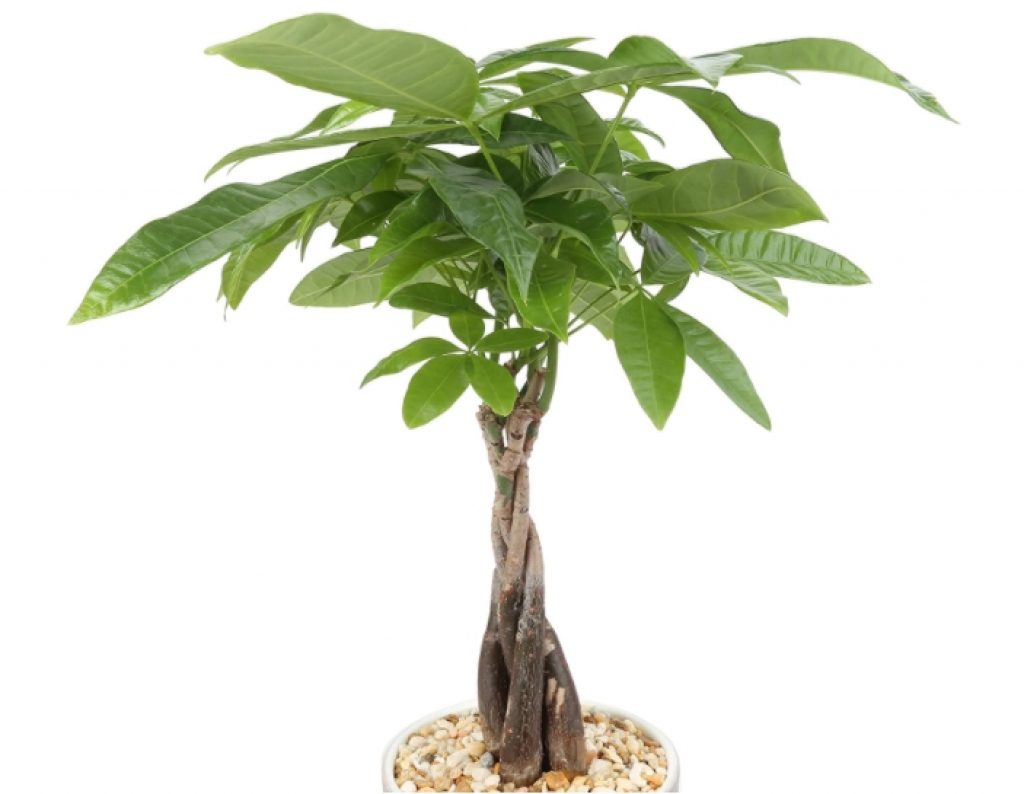Belonging to the family Malvaceae (mallow family), Pachira aquatica is a tropical marshy or swamp growing plant native to South and Central America.
It is known by other names such as Malabar chestnut, Guiana chestnut, French peanut Provision tree, Monguba, Saba nut, or Pumpo, as well as money plant or money tree (shared with other houseplants)

Guiana chestnut is often sold as a braided trunk houseplant. However, most of the smaller houseplants marketed as P. aquatic are Pachira glabra (Guinea peanut, Saba nut, lucky tree, or French peanut). The two share some common names, including Malabar chestnut.
Safety to pets
Guiana chestnut or Pachira aquatica is not toxic or poisonous to cats or dogs. Therefore, you can include it as one of your garden or house trees with braided trunks or in bonsai form. You will love the green palmate leaves, smooth bark green, and the large red flowers.
Pachira aquatic joins other cat-friendly plants like Peperomia, air plant (Tillandsia), lipstick plant, cast iron plant, hoyas, true palms like parlor, areca, ponytail or pigmy date palm, Christmas cactus, bromeliad plants, among others that are safe for kitties.
Growing
If you love this tropical wetland tree, you need to know that it can adapt to various conditions and is quite durable so long as the place is frost-free and moist. Some of its essential requirements include the following:
- Light: This money tree can grow where there medium to bright indirect light. If grown outdoors, it needs partial shade to full sun.
- Watering: water it heavily but let the topsoil dry up to a depth of 2-3 inches before watering it again. However, during the resting or winter months, give them less water and ensure your pot has drainage holes as soggy soil will cause root rot.
- Temperature: Ideal temperature is 60-90 degrees Fahrenheit but can tolerate much lower temperatures so long as there is no freezing.
- Humidity: Like any other tropical plants, it requires high humidity. Having a tray filled with pebbles and water beneath your growth pot will help keep the humidity high.
- Soil: ideal soil should be loamy and well-drained. Any potting soil that drains quickly will work well for this plant as soggy and heavy soils will cause root rot.
- Fertilizer: Feed it with balanced, half-strength plant food once or twice a month during growth months (spring and summer).
Other money plants
Since it shares the name money trees or plants with many other plants, we thought it best to mention them here and state if they are poisonous or safe.
| Name and family | Common name | Toxicity |
| Crassula ovata (family Crassulaceae, the orpine or stonecrop family). | jade plant, lucky plant, money tree, money plant, Baby Jade, Japanese rubber plant, jade tree, Chinese rubber plant, or Japanese rubber plant | Toxic to cats and dogs due to unknown reasons. Will cause vomiting, depression, and incoordination |
| Pilea peperomioides (family Urticaceae or the nettle family) | Missionary plant, UFO plant, pancake plant, blender plant, lefse plant, or mirror grass | Non-toxic to cats and dogs |
| Epipremnum aureum (Araceae) | Pothos, money plant, hunter’s robe, devil’s ivy, golden pothos, silver vine, ivy arum, marble queen, house plant, Solomon Island ivy, taro vine, Ceylon creeper | Toxic to cats since they have insoluble calcium oxalates that will cause painful and severe oral irritation, drooling, swallowing difficulties, and so on. |
| Hydrocotyle vulgaris (Araliaceae) | Common pennyworth, water naval, copper coin, marsh pennywort, or lucky plant | Non-poisonous to dogs and cats |
| Lunaria (familyBrassicaceae, the crucifers, cabbage or mustard family) | Silver dollar, dollar plant, moonwort, honesty, dollar plant, or money plant | Not toxic to dogs or cats |
